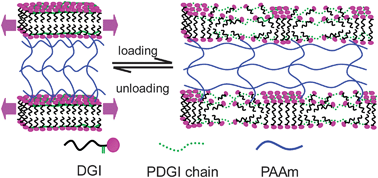In this highlight, we introduce a novel anisotropic hydrogel with a perfect 1D photonic crystal structure based on the uniaxial alignment of lamellar bilayers. The gel was synthesized in a one-pot polymerization from a precursor solution containing a polymerizable surfactant (dodecyl glyceryl itaconate: DGI), acrylamide, and a cross-linker. By applying shear flow to the precursor solution, lamellar bilayers of self-assembled DGI were aligned in one direction parallel to the substrate surface. The polymerized lamellar bilayers were stacked periodically and entrapped in the polyacrylamide matrix to give a hydrogel with a 1D photonic crystal structure. This hydrogel, containing 94–95 wt% water and 1.0–1.5 wt% bilayer molecules, shows perfect one-dimensional swelling, strong anisotropy in the elastic modulus, and magnificent structural color by multilayer interference according to Bragg's law of diffraction. Owing to the softness and large deformability, the color of the gel can be reversibly tuned by both compressive and tensile mechanical stimuli over the entire wavelength range of visible color. The single-domain lamellar bilayer not only diffracts light but also serves as a reversible sacrificial bond that dissociates upon deformation, exhibiting large hysteresis as an energy dissipation mechanism, which gives the gel high tensile strength and fatigue resistance. Both the molecular dissociation and lipid-like mobile nature of DGI molecules in the bilayers dramatically enhance the resistance against crack propagation by the formation of extraordinary blunting, which gives the gel an extraordinarily high toughness.

You have access to this article
 Please wait while we load your content...
Something went wrong. Try again?
Please wait while we load your content...
Something went wrong. Try again?


 Please wait while we load your content...
Please wait while we load your content...